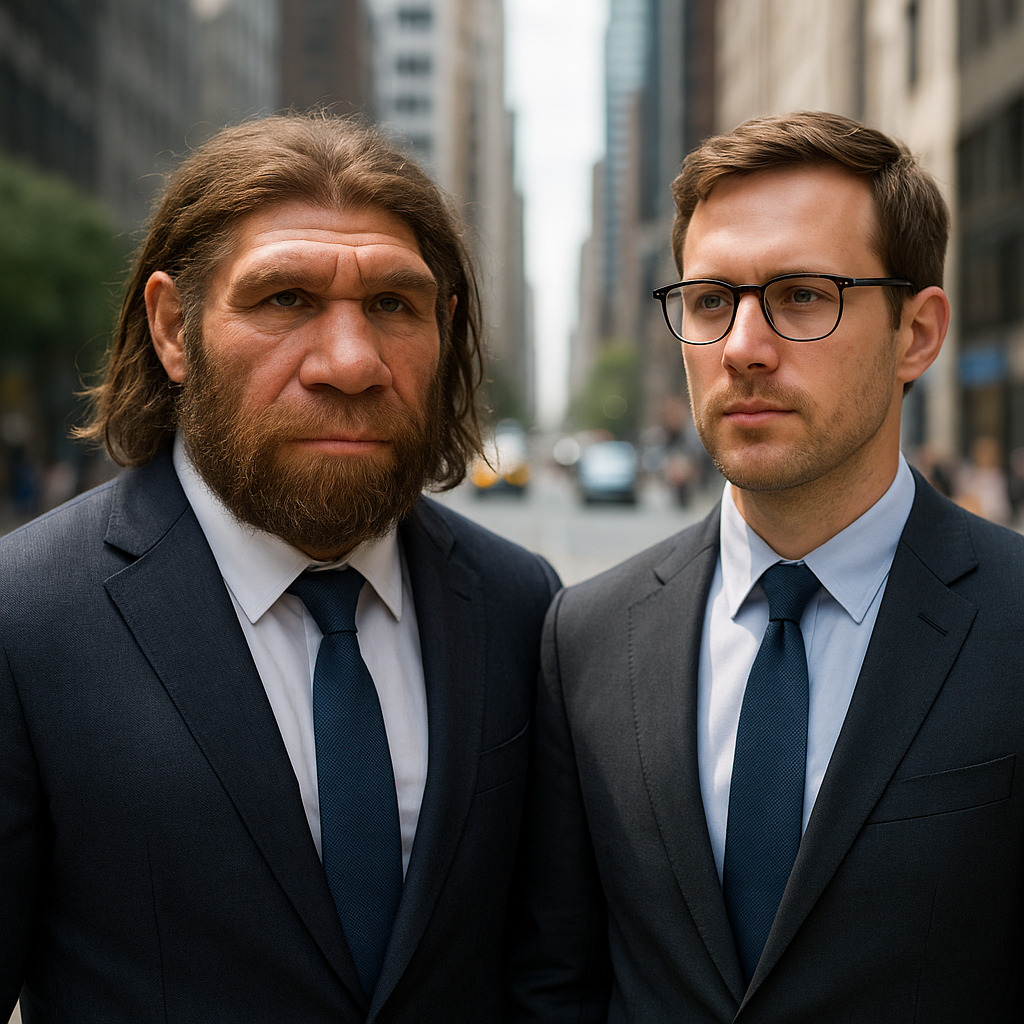Two Humanities, One Planet – What If Neanderthals Had Survived?
Introduction
In the remote past of our species, Homo sapiens, we shared a stretch of our evolutionary journey with another humanity: the Neanderthals.
Today, that species has been extinct for thousands of years. But…
Have you ever wondered what our present would be like if Neanderthals had survived the ice ages, the ecological crises, and even contact with us?
In an alternate world, they might still live beside us: two human species, one planet.
What if history had taken a different path?
Today we’ll explore a compelling question—grounded in science yet open to possibility:
What would our society look like if Neanderthals had never gone extinct?
1. Scientific Foundations: Neanderthals, Like Us but Different
Neanderthals (Homo neanderthalensis) were not brutish or primitive creatures, but fully human in many senses.
Emerging around 400,000 years ago, they inhabited vast territories across Eurasia, adapting to the harsh climates of the Pleistocene.
Genetic studies have shown that every non-African human today carries between 1% and 4% of Neanderthal DNA, proof that the two species not only encountered each other, but interbred.
In short: we were compatible.
Recent findings reveal that Neanderthals had:
- A cranial volume equal to or larger than ours (up to 1,600 cm³),
- Symbolic capacities (engravings, burial rituals, use of pigments),
- A potentially complex spoken language, based on bone structure and the FOXP2 gene,
- And perhaps even musical aptitude (as suggested by the Divje Babe flute).
Their extinction, around 40,000 years ago, was not inevitable.
Leading theories suggest:
- Sudden climate shifts,
- Ecological competition with Homo sapiens,
- Low population density and limited resilience to shocks.
2. If They Were Still Here: A Plausible Modern Scenario
Had Neanderthals avoided extinction, today they could exist as a minority intelligent population, concentrated in isolated or colder regions—the Alps, the Caucasus, Siberia.
They might represent 1–2% of the global population, with distinct cultural practices, dialects, and community structures.
Cultural Convergence
Given the genetic compatibility and evolutionary closeness, it's likely that over time a form of coexistence would have emerged.
Rather than permanent conflict or full integration, we'd see a dynamic interaction—trade, intermarriage, shared rituals.
Much like contact between ethnic groups today, Neanderthal culture would have influenced art, architecture, music, and even religious systems.
Dual Neurodiversity
The Neanderthal brain was structurally different—wider, with more developed occipital lobes and stronger visuospatial abilities.
This suggests a different cognitive profile: less abstract but more sensory-driven, tactile, and oriented toward spatial memory.
In a modern society, Neanderthals could excel in visual arts, sculpture, engineering, and fields requiring manual precision and spatial reasoning.
Our idea of intelligence itself would be broader, redefined to include different cognitive modes.
3. Social Implications: Inclusion, Conflict, or Recognition?
Having a second human species on Earth would raise deep ethical and political challenges.
- Legal status: Neanderthals would eventually gain full citizenship, but only after a long historical process of exclusion and advocacy.
- Education systems: Schools would likely adapt to serve multiple cognitive styles, requiring bilingual education, neurodiverse pedagogy, and hybrid curricula.
- Xenophobia and prejudice: Like other marginalized groups, Neanderthals would face discrimination, biological racism, and identity-based movements—from Neanderthal nationalism to sapiens supremacism.
Yet in a mature society, diversity would be embraced not just culturally, but biologically—and seen as a source of collective intelligence.
4. Neanderthals in Us: Genetic Echoes
In some ways, Neanderthals are not entirely gone.
Their genes are still active in our biology and behavior.
For example, Neanderthal DNA influences:
- Immune system response,
- Pain sensitivity,
- Certain circadian rhythms,
- And even predispositions to addiction and stress adaptation.
They are part of us.
Conclusion – Could Another Humanity Have Changed Us?
Had Neanderthals survived, our concept of what it means to be “human” would be fundamentally richer.
Their presence would force us to confront questions of identity, rights, intelligence, and empathy.
And perhaps, in learning to understand another human species,
we would have better understood ourselves.
Because sometimes, to know who we are,
we need to look into the eyes of someone like us—yet not us.








Leave a Comment